Let’s get this blog started with a bang!
How about feminist ninjas?
When deciding the lady with which I wanted to start this blog, I had several choices to make. Should I choose a fighter or a leader? A woman who led troops, or an activist who promoted women’s rights?
Fortunately, a woman exists who did both!
Okay, so she wasn’t technically a ninja. But she did practice ju-jitsu, a Japanese style of combat developed for smaller, unarmed opponents to defeat larger, armed enemies. And she did teach ju-jitsu to others. Not just taught – she trained up to 30 women to serve as a bodyguard squad for feminist leader and professional troublemaker Emmeline Pankhurst.
And by ‘bodyguard squad’, I mean ‘let’s fight off the cops trying to arrest us.’
Let’s set the scene: 1908, London. The past few generations have not been kind to women. Though England had recently been ruled by a woman (Queen Victoria, reigned 1837-1901), the advent of industrialism found women’s social and political power severely curtailed. A few women thought these attitudes were just so much bullshit, and figured the best way to fight back was by giving women the vote; among them Emmeline Pankhurst.
Emmeline was rather like the Malcolm X of the British suffragette movement. Impatient with Parliament, she decided to take action. And by ‘action’, I mean throwing rocks through windows, setting fires and generally causing mayhem in the name of women’s suffrage. The long-term effectiveness of her methods have been criticized, but she did keep her movement in the papers. As you might imagine, Pankhurst found herself dragged off to jail on more than one occasion.
What ensued, starting in 1913, quite literally became a game of Cat and Mouse: Emmeline gets arrested. Emmeline stages a hunger strike while imprisoned, becomes ill. Emmeline gets released. Emmeline gets better. Cops come looking for Emmeline to throw her back in jail.
Enter one Edith Margaret Garrud. Even without her connection to the suffragettes, Edith would still have gone down in history as the first European woman to teach martial arts in the West. She and her husband learned ju-jitsu from Mr. Edward William Barton-Wright (known as the founder of Bartitsu, which hardcore Sherlock Holmes fans might recognize). Edith also appeared in film and theatrical productions, using her skills as a fight choreographer to stage some very cool combats. An impressive career for a Victorian lady, indeed. Especially for one who never grew past 4’11”.
But wait, there’s more!
Edith joined up with Emmeline and the other suffragettes in 1908. And in 1913, with the passage of the “Cat and Mouse Act,” Edith began training more women in the art of ju-jitsu; so that when those cops came to re-arrest Emmeline, the Bodyguard (as they were called) could successfully fight them off. Of course, this didn’t thrill the cops, which meant Edith had to teach her students in secret.
Yes, that’s right. She not only taught ju-jitsu, she founded a secret society of martial-arts suffragettes. Aside from ju-jitsu, the Bodyguard also employed various diversionary and deceptive tactics to foil the police trying to tail them. You know. Like ninjas.
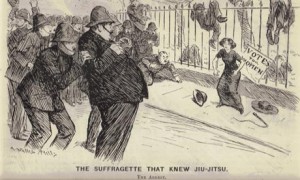 The press called it ‘suffrajitsu.’
The press called it ‘suffrajitsu.’
When Emmeline showed up at rallies, the police then arrived with the intent of subduing and arresting her. At which point, the Bodyguard surrounded Emmeline and engaged the cops long enough for Pankhurst to make her escape. Though ju-jitsu emphasizes unarmed combat, these women would sometimes come armed with meels – weighted wooden bowling pins, ideal for hiding under long Edwardian skirts. And in lieu of corsetry, the Bodyguard instead wore several inches of cardboard around their midsection to avoid getting their ribs cracked.
And rib-cracking was a very real risk. It turns out the gentlemanly ideal of ‘not hitting a woman’ flies right out the window when said woman threatens a gentleman’s other ideal of ‘the men get to be in charge.’ No Bodyguard died or faced serious injury (that I could uncover), but these women often went home with exactly the sort of injuries you’d expect from such brawls. And they did it repeatedly. In one famous case, after fighting through the Bodyguard (and some cleverly hidden barbed-wire booby traps), the cut-up police knocked out and arrested Emmeline Pankhurst… only to discover they’d captured her body double. The real Emmeline Pankhurst had escaped.
Edith, for her part, largely stayed away from these fights. As the leader and trainer of the Bodyguard, her position was too valuable to risk her arrest. However, her students applied the tactics and techniques they’d been taught with an iron-willed determination. Even though Edith wasn’t on the front lines for every scrap, she still deserves quite a lot of credit for her bravery and dedication to promoting the rights of women. And the idea of a fighting force of women was so novel to the Victorians that the press couldn’t get enough of them. As a result, Edith helped keep the suffragettes and their movement in the newspaper – Priority #1 when you’re an activist.
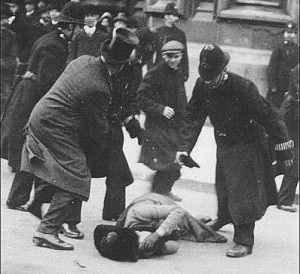 To that last end, Edith also wrote. In her article Damsel v. Desperado, published in 1910, Edith promotes ju-jitsu as a way for women (and men, she adds almost as an afterthought) to protect themselves from criminals. When many recommended women find men to keep them safe, Edith said women could, and should, protect themselves.
To that last end, Edith also wrote. In her article Damsel v. Desperado, published in 1910, Edith promotes ju-jitsu as a way for women (and men, she adds almost as an afterthought) to protect themselves from criminals. When many recommended women find men to keep them safe, Edith said women could, and should, protect themselves.
In addition to her activism, writing and choreography, Edith participated in a strange little sketch called “Ju-Jitsu as a Husband-Tamer: A Suffragette Play with a Moral!” The extent of her involvement is unknown, but one writer describes watching a rehearsal in her studio – undoubtedly, Edith lent her choreographic talents at the very least. In this sketch, a lower middle-class woman must cope with a husband who gets drunk and beats her. She responds with ju-jitsu, and the husband and wife eventually reconcile after the husband finds himself knocked on his arse (and forswears alcohol. Remember, early 20th century women’s activism was tied up in the temperance movement). It’s a morality play of sorts, and while the tactics described would likely not work in a real-world setting, the idea remains that women ought to be prepared to literally fight back against those who would oppress or abuse them.
Emmeline and Edith suspended their activities with the onset of World War I, when both women decided to support their government during the war. As it happened, women slowly gained greater suffrage both during and shortly after the war, gaining full suffrage in 1928.
Edith retired from public life at age 53, in 1925. However, she lived to be ninety-nine years old, living long enough to see men land on the moon and the birth of Second Wave feminism.
Edith Margaret Garrud has been commemorated with a plaque in Islington, where she lived for many years.
A webcomic featuring Edith has been published, under the entirely-appropriate title Suffrajitsu! She also has a children’s book about her, Edith Garrud: The Suffragette Who Knew Jujutsu. You can also watch a short YouTube documentary about her. She also appeared as a character in a 2012 play about British suffragettes, The Good Fight. Edith also appeared in a 1984 docu-drama which no one seems able to locate. However, a movie called Suffragette is due to be released in 2015. Meryl Streep plays Emmeline Pankhurst, and Helena Bonham Carter is credited as… Edith New? But another actress, Charlotte Day, gets credit as ‘Jujitsu Lady’; and Corinne Curtis as ‘Jiu Jitsu Suffragette’, so here’s hoping Edith has at least a cameo!
Resources
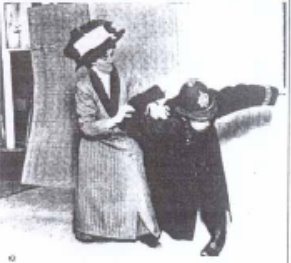
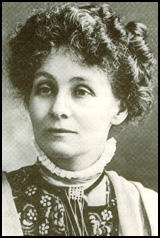
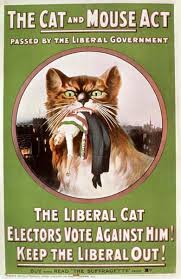
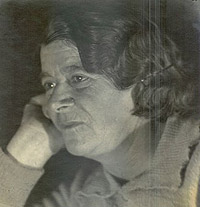
4 Comments